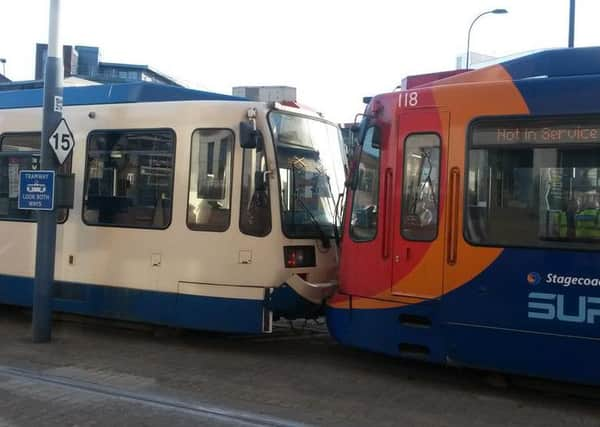Tram '˜not being driven appropriately' during Sheffield tram crash - FULL REPORT published


The tram crash in October 2015 saw a blue route tram and a yellow route tram collide at Shalesmoor tram stop.
The smash left both vehicles out of service for several weeks and led to the cancellation of some purple route services due to the shortage of available vehicles in Stagecoach Supertram’s fleet.
Advertisement
Hide AdAdvertisement
Hide AdA report published today by the government’s rail safety group the Rail Accident Investigation Branch said that one of the trams was ‘not being driven in a manner appropriate for the conditions’ when it collided with another tram at the stop.
The report said: “The collision occurred in conditions of low rail head adhesion on the approach to Shalesmoor tram stop at the time. Tram 120 was not being driven in a manner appropriate for the conditions, and its brakes did not provide the level of braking the driver expected.”
Low rail adhesion effectively means poor traction on the rails. The report explains that the rails were often clogged with leaves and other detritus at Shalesmoor which affected stopping distances.
The report found that Stagecoach Supertram’s management of low rail adhesion “was not compliant with its own procedures” and was “an underlying factor” in the crash.
Advertisement
Hide AdAdvertisement
Hide AdIt also said that traffic on Netherthorpe Road contributed to the crash, because queueing traffic meant that the tram standing at Shalesmoor - which was crashed into - was unable to proceed because of queueing traffic in the yellow box junction on the road.
It added: “An additional factor was that at the time, tram 118 was at the tram stop and had not been able to depart prior to the collision because it was blocked by road traffic queuing at a yellow box junction ahead.
“As a result of this investigation the RAIB has made one recommendation for UK tram operators relating to reviewing and where necessary improving, their processes for managing the risks from low adhesion conditions.
“The RAIB has also identified one key learning point relating to the performance of magnetic track brakes when the rail head has low adhesion.”
Advertisement
Hide AdAdvertisement
Hide AdThe report added that the tram’s driver had ‘more than 20 years’ experience’ driving trams in Sheffield, and that both tram drivers were tested for alcohol and drugs and found to have none in their systems.
The report concluded: “This accident demonstrates that the performance of friction-type magnetic track brakes can be adversely affected by rail head contamination in a similar way to the friction brakes on the wheels.
“Tram drivers should therefore adopt a defensive driving style in low adhesion conditions that does not place undue emphasis on the added braking effort provided by the track brakes.”
A spokeswoman for Supertram said: “We accept the RAIB’s findings. There were no serious injuries caused as a result of this incident, however as the safety of our people and our passengers is our top priority, we also carried out our own investigation into the circumstances. As a result of this, and of the RAIB’s recommendations, we have made amendments to our low adhesion management process.
“In addition, the driver involved in the incident has undergone re-training.”